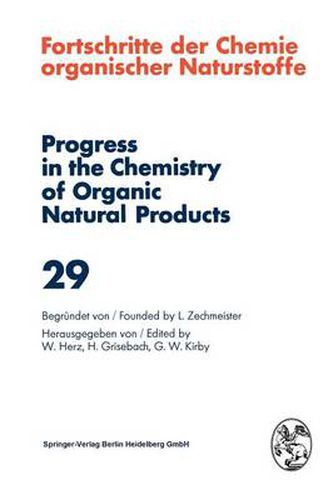Fortschritte der Chemie Organischer Naturstoffe / Progress in the Chemistry of Organic Natural Products 29

Fortschritte der Chemie Organischer Naturstoffe / Progress in the Chemistry of Organic Natural Products 29
This title is printed to order. This book may have been self-published. If so, we cannot guarantee the quality of the content. In the main most books will have gone through the editing process however some may not. We therefore suggest that you be aware of this before ordering this book. If in doubt check either the author or publisher’s details as we are unable to accept any returns unless they are faulty. Please contact us if you have any questions.
Eine grosse Anzahl heterocyclischer Naturstoffe leitet sich vom Ring- system des Piperidins (1) ab. Als Substituenten einfach oder mehrfach substituierter Piperidinbasen finden sich Methyl-, Carboxyl-, Hydroxyl- und Aminogruppen sowie aliphatische Seitenketten unterschiedlicher Lange. Die Substitution erfolgt bevorzugt an den C-Atomen 2, 3 und 6 sowie am Heteroatom. In zahlreichen Fallen ist der Piperidinring in a- oder ss-Stellung direkt oder uber eine C-Brucke mit einem weiteren Heterocyclus verbunden, z. B. einem Piperidin-, Piperidein-, Pyridin-, Indol-, Chinolizidin- oder Furanrest. Daruber hinaus kann der Piperidin- ring zum 2,6-Dioxopiperidin (Glutarimid) oxydiert oder zum Pipendein dehydriert sein. Wahrend Naturstoffe mit Pyridinstruktur im Tier- und Pflanzenreich weit verbreitet sind und einzelnen von ihnen wie NAD oder Pyridoxal- phosphat als Coenzymen des Primarstoffwechsels besondere Bedeutung zukommt, handelt es sich bei den naturlichen Piperidinverbindungen im allgemeinen um sekundare Pflanzenstoffe (vgl. I8, I9I). Dabei sind einige wie z. B. die Pipecolinsaure (7) sporadisch auf verschiedene Pflanzen- familien verteilt. Andere Piperidinbasen wie die Conium- oder Piper- Alkaloide weisen dagegen eine ausgesprochene Artspezifitat auf. Im Gegensatz zu den meisten Pyridinalkaloiden finden sich die Piperidin- basen oft mit strukturell andersartig gebauten Alkaloiden vom Chino- lizidin- oder Trepantyp vergesellschaftet, was in den meisten Fallen durch eine enge biogenetische Verwandtschaft bedingt sein durfte.
This item is not currently in-stock. It can be ordered online and is expected to ship in 7-14 days
Our stock data is updated periodically, and availability may change throughout the day for in-demand items. Please call the relevant shop for the most current stock information. Prices are subject to change without notice.
Sign in or become a Readings Member to add this title to a wishlist.


